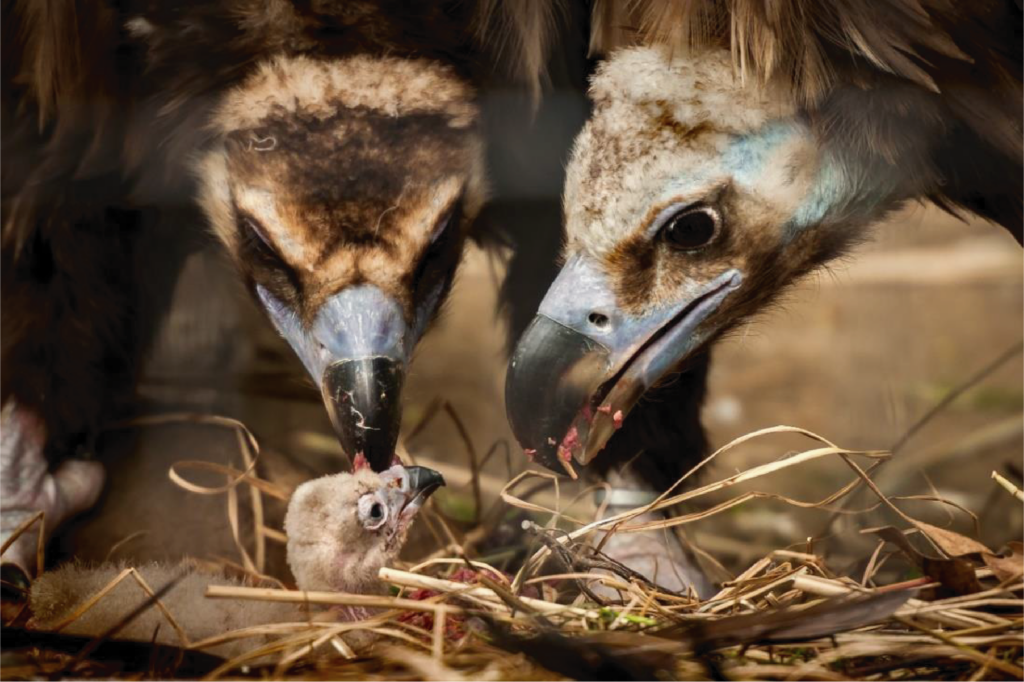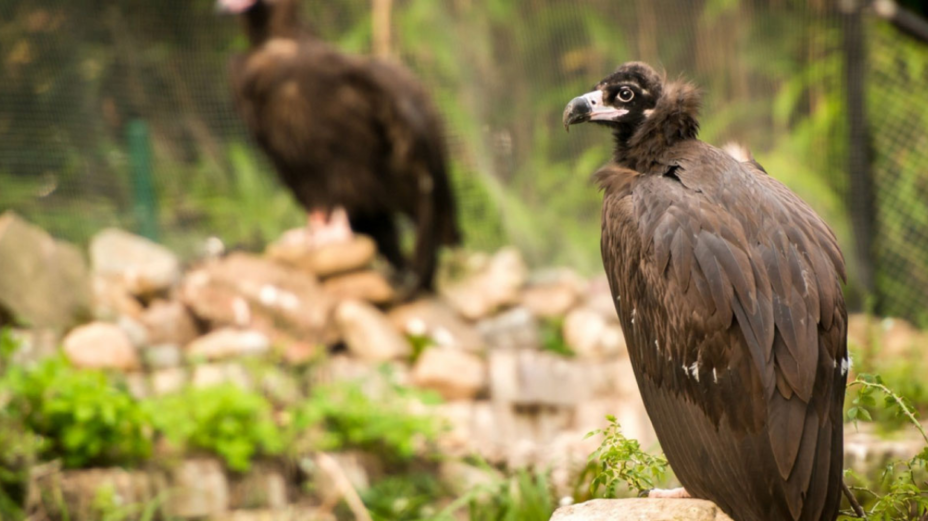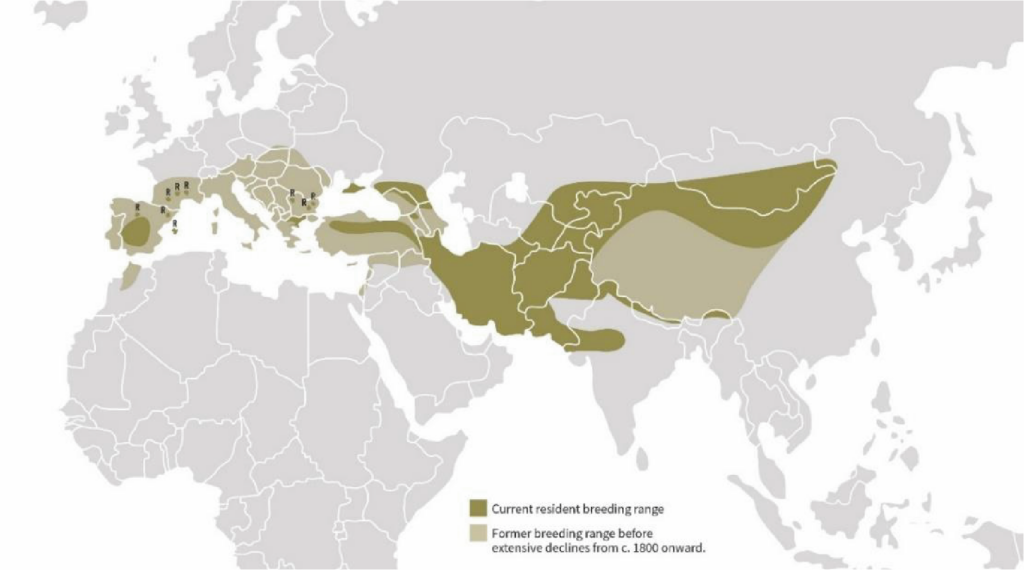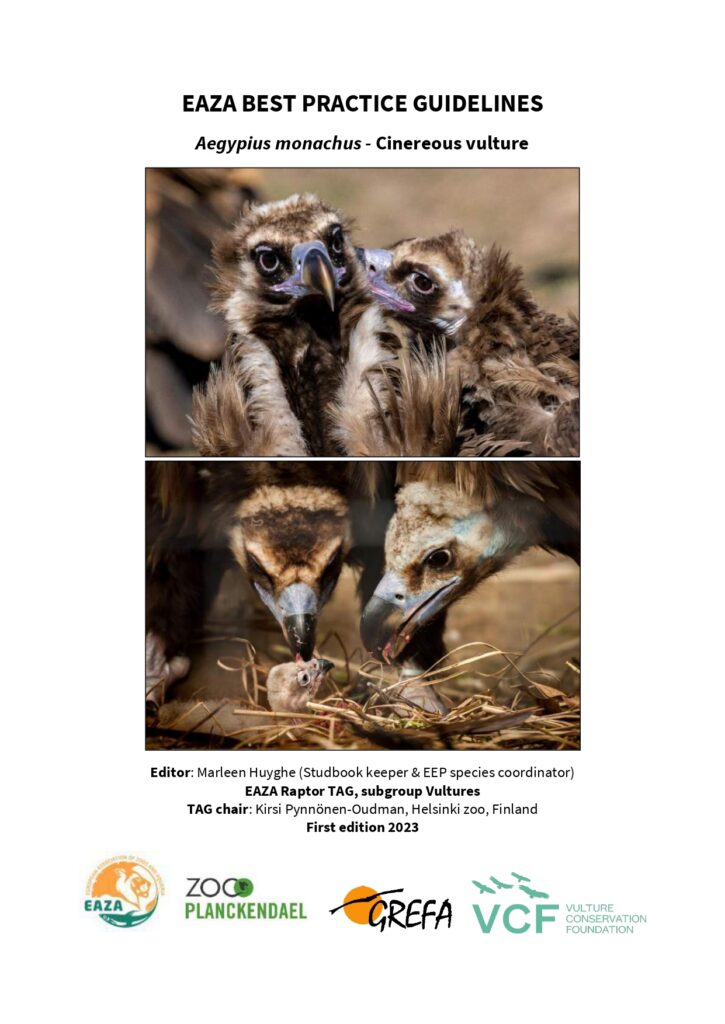After extensive work coordinated by the Cinereous Vulture European Endangered Species Programme (EEP) of the European Association of Zoos and Aquaria (EAZA) that involved experts from the Zoo Planckendael, GREFA, the Vulture Conservation Foundation (VCF) and Parc des Oiseaux, the new “EAZA Best Practice Guidelines for Cinereous Vulture” (Aegypius monachus) was recently published. The aim is to encourage and promote the highest possible standards for husbandry of this species in captivity.


EAZA Best Practice Guidelines for Cinereous Vulture
The Best Practice Guidelines for Cinereous Vultures aim to promote animal welfare and healthy populations within the Cinereous Vulture EEP members and beyond. The guidelines should not be considered minimum requirements but a comprehensive collection of good husbandry practice, building from the experience of the many experts involved since the former version of the guidelines back in 2009.
The process started in December 2019, with a meeting celebrated in Antwerp Zoo. Experts working with Cinereous Vultures, both in captivity and in the field, were invited to exchange knowledge and plan the edition of these Guidelines, to improve the breeding success of captive birds and create a document pleasant and easy to read. The edition of the Guidelines took more than two years. According to Àlex Llopis, ex-situ vulture expert for the Cinereous Vulture EEP and VCF Vultures Captive Breeding Manager, “the most difficult thing has been finding ways to describe behaviours without being misunderstood, especially for those new EEP participants without previous experience with the species.” After multiple video conferences and phone calls, the experts tried to answer every doubt, taking the time to reflect alone before coming back together to find the best solutions.
“It has been tough work but very satisfying and fulfilling, especially with the team we have brought together, as we have always jointly sought to include everyone’s opinion. Truly a very satisfying work!”
Àlex Llopis
Managing Cinereous Vultures in captivity
The first chapter includes an overview of the current knowledge of the species regarding its biology and ecology, breeding and behaviour patterns, distribution and main threats. Cinereous Vultures are sensitive to disturbances; they need to feel safe in their housing and require special care to thrive in captivity. Therefore, the second section deals with Cinereous Vulture management in zoos, with an extensive description of conditions that should be fulfilled and optimal prerequisites for keeping Cinereous Vultures in captivity. These include desirable enclosure design, diet and nutrition, veterinary care, breeding and rearing, and behaviour management.
The second chapter of the Guidelines is dedicated to captive management and includes detailed information on:
- the structure, size and maintenance of enclosure and acclimatization cages, with practical and visual examples from other facilities;
- Diet and nutritional needs of Cinereous Vultures, including recommended types and quantities, feeding schedules and supplementation;
- Breeding and rearing, including recommendations for selecting breeding pairs, egg laying and incubation (natural and artificial) and bonding behavioural patterns;
- Social structures and behaviour management;
- Handling, transportation and safety;
- Veterinary care, treatment of diseases and post-mortem procedures.

The majestic and threatened Cinereous Vulture
With 3 meters wingspan, the Cinereous Vulture is the largest vulture species in Europe and one of the heaviest birds of prey in the world. Its scientific name derives from the Greek word for “vulture”, Aegypius, and the Latin word for “hooded”, monachus. Individuals can live for 20-30 years in the wild and up to 40 in captivity. In Europe, younger birds disperse over large areas, while adults tend to be sedentary.
The main threats affecting Cinereous Vultures include (unintentional) poisoning, persecution, habitat loss, electrocution and collision with energy infrastructure. In the 20th century, these disturbances led to its extinction in many areas of its former distribution range. In Europe, only two populations survived in the wild: a western population in the Iberian Peninsula (Spain) and an Eastern one in Dadia-Lefkimi-Soufli Forest National Park, Greece. Currently, the global Cinereous Vulture population extends from Europe to Asia and is considered extinct in Africa (Birdlife, 2022).
Securing a future for Cinereous Vulture wild populations
The Cinereous Vulture is considered “Nearly Threatened”, according to the IUCN Red List, evaluated by BirdLife International (2021). Over the last decades, the European Cinereous Vulture population has been recovering and expanding its breeding range, thanks to several reintroduction and restocking efforts. Spain, which hosts the most significant European Cinereous Vulture population, with over 2500 estimated breeding pairs (see the VCF’s Population estimates for the five European vulture species across the Mediterranean, 2022 update), is an essential partner in restocking efforts ongoing in other countries.
The population in Greece is stable, with a breeding colony established in Dadia Forest National Park. In Bulgaria, the LIFE RE-Vultures and Vultures Back to LIFE projects, were milestones to restore the breeding populations of Cinereous Vulture. In France and Portugal, additional breeding pairs have been recorded over the years, thanks to conservation actions to mitigate threats and improve habitat for the Cinereous Vulture. Currently, the ambitious LIFE Aegypius Return project aims to double the existing breeding population along the border between Portugal and Western Spain, by 2026, while the Balkan Detox LIFE is strengthening national capacities in 7 Balkan countries to fight wildlife poisoning, the main threat affecting the species’ survival.
The role of the Cinereous Vulture EEP
The European Endangered Species Programme (EEP) is the most intensive type of population management for a species kept by the European Association of Zoos and Aquaria (EAZA) members. It is a captive-breeding programme that aims to conserve sustainable backup populations of animals in captivity while safeguarding the genetic diversity up to 90%. Animals born in captivity can then be used to boost populations in the wild.
The Cinereous Vulture EEP is made up of 43 zoos and animal parks ranging from Spain to Kazakhstan and is home to about 40 breeding pairs. It is managed by the studbook keeper and coordinator Marleen Huyghe from Zoo Planckendael in Belgium, also an Advisory Board member for the Vulture Conservation Foundation (VCF). The VCF also shares expertise and experience to help update guidelines and protocols.

Cinereous Vultures originating from the EEP were reintroduced in Mallorca, Spain (Boumort), France (Causse, Baronnies, Verdon) and Bulgaria (Sliven, Kotel). These sites are indicated on the map with “R”, source: Huyghe M., Izquierdo P., Bureau E., Llopis A.
International collaboration and close coordination are crucial to secure the future and ensure the genetic diversity of the European Cinereous Vulture population. With these clear and practical guidelines for husbandry, EAZA and all experts involved, hope to contribute to conservation efforts and ensure animal welfare in all captive facilities.
Source:
Huyghe M., Izquierdo P., Bureau E., Llopis A. (2023) EAZA Best Practice Guidelines for the cinereous vulture, Aegypius monachus. European Association of Zoos and Aquaria, Amsterdam, The Netherlands.




